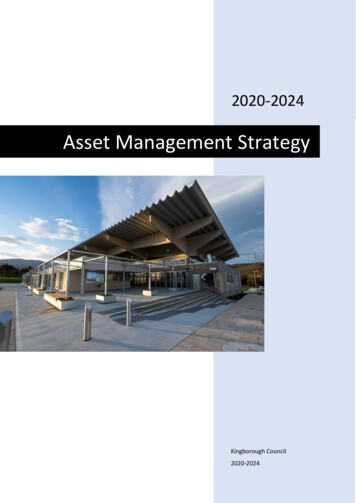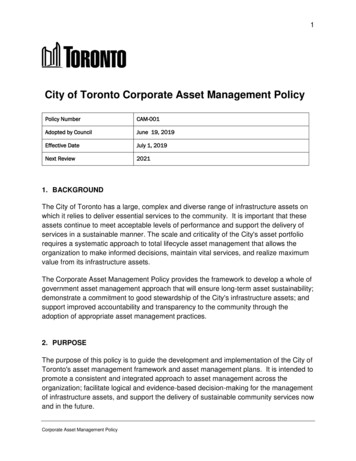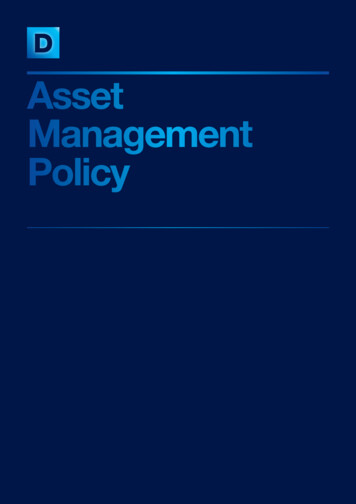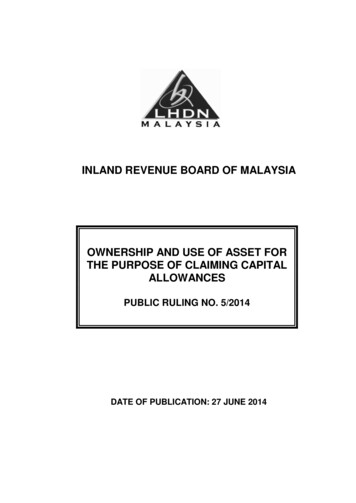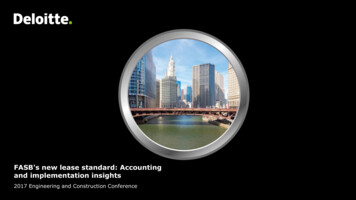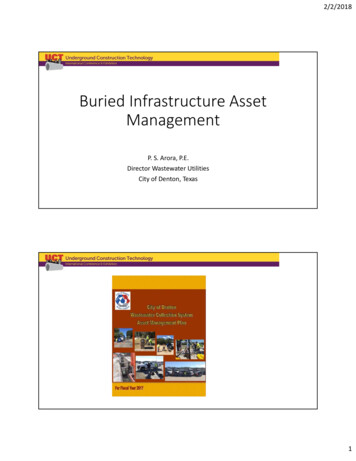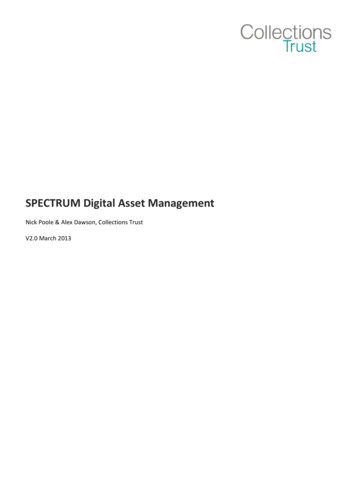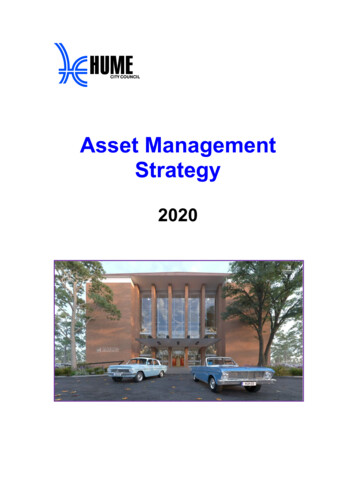
Transcription
Asset ManagementStrategy2020
ContentsIntroduction . 1Purpose . 1Council Assets . 1Council’s Asset Management model . 34.1Relationship with Corporate Planning Process. 34.2Asset Management Documents Hierarchy . 45. Asset Management Systems, Data and Processes . 55.1Systems. 55.2Data . 55.3Processes. 66. Asset Management Strategies. 87. Council’s Asset Management involvement with the STEP program . 88. Asset Management Structure. 109. Improvement Opportunities . 1010.Monitoring & Review. 1010.1 Resource Implications . 1111.Conclusion . 1112.References . 1113. Appendix .121.2.3.4.
1.INTRODUCTIONAn Asset Management Strategy is a key link in the chain of actions required for a sound process ofimproving the long-term management of infrastructure assets. The Asset Management Strategyestablishes the framework that determines the nature and direction of asset management. Itsobjective is to provide a structured set of actions aimed at enabling improved asset managementpractice.This strategy provides the framework to guide the development of an integrated and comprehensiveinfrastructure Asset Management model for Hume City Council. Infrastructure Asset Management is acombination of management, financial, economic, engineering and other practices applied toinfrastructure assets with the objective of providing the required level of service in the most costeffective manner.Asset Management aims to ensure that the activities and practices are systematic and coordinated inorder to support wide range of Council Services. This strategy presents existing Asset Managementpractices and proposed further improvements required to identify and meet appropriate levels ofservice to the community. A structured set of improvement actions, listed in Appendix 1, has beenidentified consistent with Council’s Asset Management Policy and Council Plan 2017-2021.2.PURPOSEThe strategy describes the current status, vision and actions for consolidating Asset Managementwithin Hume City Council. The Strategy: 3.Links and integrates Council Plan and resources, indicating which services are to be deliveredthrough which assets;Outlines the budgetary framework to be used for asset management;Outlines asset management practices, systems and improvements.Aims to assist Council to progress through on-going reviews of its Asset Management Plans (AMP)and establish a framework for the on-going enhancement of Asset Management practices to meetcommunity needs.COUNCIL ASSETSCouncil currently owns and maintains over 2.45 billion worth of infrastructure assets including roads,drainage, buildings, bridges, footpaths and open space Assets. All assets are valued using the greenfieldreplacement costs which were adopted by Council’s Finance Department in the last year’s valuation;except for the Building asset category (Greenfield Values are not relevant for Building Components).These assets make up the economic and social infrastructure that enables the provision of services tothe community and businesses, playing a vital role in the local economy and on quality of life.Details of the extent of these assets are included in Table 1.This Strategy covers infrastructure assets only, which include following Asset Groups:Document:Asset Management StrategyApproved By:CouncilDocument No.:Date Approved: September 2020Page 1
REPLACEMENTVALUE ( M)ASSET GROUPDESCRIPTIONRoadsRoad pavement, road surface, unsealed road,shoulder, kerb & channel, carpark, roundabouts, road 1,027islands, crash barriers, traffic management devices.Street footpaths and shared footpaths on local andarterial roads and state highways. Also includesshared paths in open space.Road bridge, major culverts, pedestrian bridge andjetties.FootpathsBridgesDrainageParks and OpenSpaceBuildings20488Pits, pipes, gross pollutant traps and WSUD assets.Park furniture, sports fields including active turf,artwork, water fountain, playspace, gazebo, shelters,garden beds, landscaping, etc.Municipal offices, aquatic centres, preschools,community facilities, maternal & child health centres,toilets, pavilions, etc.589Total Value2,454108438Table 1: Replacement Value of All Asset Classes (at 30 June 2019)% of Assets - Based on Replacement CostBuildings - 18%RoadsOpen Space Assets - 4%Roads - 42%FootpathsBridgesDrainageDrainage - 24%Parks and Open SpaceFootpath - 8%BuildingsBridges - 4%Hume’s assets are relatively young and as such do not require a high level of renewal works at thisstage. As the assets become older, it is anticipated that the need for renewal funding will start toescalate. Based on asset condition and age, a total of 18.87 million would be required to replace allthose assets that have reached the end of their lives (condition 5). However, in reality assets areusually replaced or maintained before reaching Condition 5. Condition 4 has typically been used as anintervention level for renewal.Document:Asset Management StrategyApproved By:CouncilDocument No.:Date Approved: September 2020Page 2
Enhanced Strategic Asset Management Modelling will be able to forecast annual renewal budget forupcoming financial years. Strategic Asset Management Module (Technology One) will be implementedin the next few years.Figure 1 shows the Condition Profile of all Asset Classes:Condition Profile of all Asset Classes (%)5.98% 0.97%23.13%43.69%EXCELLENTVERY GOODGOODFAIR26.23%POORFigure 1: Condition Profile of All Asset ClassesOnly 0.97% (based on Replacement Cost) Assets are in poor condition.4.COUNCIL’S ASSET MANAGEMENT MODEL4.1 Relationship with Corporate Planning ProcessFigure 2 below illustrates the important relationship between Asset Management and the corporateplanning process, with key links including: Alignment between the Strategic Resource Plan and Asset Management Plans Service Plans that determine asset requirements to support desired service levels Annual plans, budgets and Capital Works Program – linking to Asset Management PlansFigure 2 : Asset Management ProcessesDocument:Asset Management StrategyApproved By:CouncilDocument No.:Date Approved: September 2020Page 3
4.2Asset Management Documents HierarchyCouncil’s written management elements comprise this Strategy, an Asset Management Policy, AssetManagement Plans and Operational Plans for various Asset Groups.The following diagram sets out the interrelationship between these elements to ensure a strategicapproach to Asset Management.COUNCIL PLANASSET MANAGEMENT POLICYASSET MANAGEMENT STRATEGYASSET MANAGEMENT PLANS FOR EACH ASSET CLASSRoads AM Plan, Drainage AM Plan, Buildings AM Plan etcOPERATIONAL PLANS FOR EACH ASSET CLASSRoads OP, Drainage OP, Buildings OPFigure 3: Hierarchy of Key Asset Management DocumentsAM Policy: AM Plan:Context and Importance;AM vision and goals;Responsibilities and relationships;Broad time frames and deadlines;Integration of AM into organisation;Audit and review. AM Strategy: Current tionFuture vision;Gap analysis;Strategies and actions to address gaps;Resources and timeframes. Levels of service;Demand Forecasts;Asset portfolio;AM activities-Operations-Maintenance-Renewals-Capital works-DisposalsFinancial Forecasts.Operation Plans: Reflects AM Plan, Priorities / Forecasts;Allocates necessary resources;Contain measurable performanceindicators;Promotes Efficient Service Delivery.The Asset Management Policy sets out the overall Council vision in regard to infrastructure assetsupport services provision and establishes the Asset Management responsibilities and relationshipsamongst Council, the Executive Management Team and Council staff in general.The Asset Management Strategy provides the link between the Policy and AMPs by recommendingstaged, prioritised improvements to be addressed over the next 4 years. Council’s Asset ManagementDocument:Asset Management StrategyApproved By:CouncilDocument No.:Date Approved: September 2020Page 4
Strategy provides the framework to guide the development of an integrated and comprehensive AssetManagement model for Council. These proposed improvements are documented in Appendix 1.The AMPs for each of the major asset groups document future demand for assets to deliver identifiedservice needs, the target service levels intended and the means by which these will be achieved on awhole of life cycle basis, along with the long-term financial projection to achieve these. The need forAMPs is legislated under section 92 of the Local Government Act 2020.The Operation Plans, to be progressively developed as required by the asset custodians for each of theasset groups, document the means by which the operations and maintenance outcomes required ofthe AMPs will be delivered.5.ASSET MANAGEMENT SYSTEMS, DATA AND PROCESSES5.1SystemsCouncil utilises a range of systems / software that serve various purposes. The following are the mainapplications that relate to Asset Management:NamePurposeTechnology One - AssetManagement SystemGeological InformationSystem (GIS - Maproom)MeritHPE Records Manager (TRIM)OwnerThis is a centralised register of all Council-ownedassets that can be linked to related customerenquiries. Currently used by various teams includingAsset Management, GIS, Finance, Technical Services,Parks and Building Maintenance.Hume’s range of GIS tools can help make decisionsbased on locality based data, allowing analysis andquick access to information on assets and customersthat can help to plan projects and make decision.Manages customer enquiries, collects data andtriggers actions for responsible officers. Forexample, used to report missing bins, potholes andother specific requests.This content manager is Council’s electronicdocument and records management system andrecords in compliance with legislation. Also knownas Kapish Explorer.Table 2: Asset Management SystemsAssetsInformation andTechnologyCustomer ServiceInformation andTechnologyTechnology One has been implemented since the adoption of the previous Asset ManagementStrategy. There is still further functionality to be deployed, such as Predictive Modelling, Life CycleCost optimisation and Budget Scenario Planning, as well as additional users to be added.5.2DataCouncil currently uses the following main data information systems, listed in Table 3, for recordingrelevant asset data information:ModuleSystemCustomer RequestMerit and TrimDocument:Asset Management StrategyApproved By:CouncilDocument No.:Date Approved: September 2020Page 5
FinancialsTechnology One – Financial SystemGISAsset Register (Asset Hierarchy andDetails)Strategic Asset ManagementCurrently Maproom; but a project isunderway to transition to Intramaps.Technology One – Asset ManagementSystemMoloney Financial Model at this stage;Technology One Strategic AssetManagement Module will beimplemented in the future.Table 3: Asset Data InformationThe Asset Register has been maintained and updated by the Asset Management Team. The GIS Teamis responsible for all the shape files and places individual objects in the GIS; a unique GIS ID has beengenerated and serves as a link between the Asset Register and GIS. Where required, customer requestsfrom Merit are generated as a Work Order in Technology One. There is a plan to integrate TRIM withTechnology One; which will enable TRIM Documents to be linked to Technology One efficiently. It isalso planned to implement the Strategic Asset Management module of Technology One in the comingyear; this will help to more accurately forecast future renewal needs for the Capital Works Budget.5.3ProcessesAsset Management processes should be integrated with Council’s wider corporate planning andfinancial planning process. An Asset Quality Management Framework has been developed to ensurethat reviews are carried out at appropriate times and that processes are delivering appropriateoutcomes.The following figure shows the relationship between the Asset Management Strategy and otherdocuments and processes.Asset Management Planning Process&Document:Asset Management StrategyApproved By:CouncilDocument No.:Date Approved: September 2020Page 6
Figure 4: Asset Management ProcessesDocument:Asset Management StrategyApproved By:CouncilDocument No.:Date Approved: September 2020Page 7
The following elements of Asset Management are in place: Asset Management PolicyAsset Management StrategyRoad Management Plan (2016)Road Asset Management Plan (2019)Buildings Asset Management Plan (Draft2019)Drainage Asset Management Plan (Draft2020)Parks and Open Space (2012)Asset Management Information System(Technology One) with comprehensiveasset register for all asset classesA Risk Management Plan Asset management processes need to be executed in a sound and competent manner. AssetManagement processes should be integrated with Council’s wider corporate planning and financialplanning process.6.ASSET MANAGEMENT STRATEGIESAsset Management strategies and their current status are outlined in Table 4.StrategiesCurrent Status1. Sustainability of asset managementAll infrastructure assets need to be managed in amanner that ensures they can be sustained andprovided the specified “levels of service” in the AssetManagement Plans.Regularly review the levels of service inconsultation with the community(Community Survey and OtherConsultations), determining financialimpacts of anychanges and incorporate changeswithin asset management plans andlong term financial plan.2. Assets to meet Community ‘Needs’Any proposal for upgrading new assets will be assessedas to community needs and it will involve a process ofcommunity consultation. As well as identifying thespecific needs of the community, the community in turnshould be made aware of issues of ongoing costs andrisks.Council conducts Community Surveysfor individual services.Community can also submit CapitalWorks proposals.3. Disposal of AssetsCurrent practice is that when an assetis to be considered for disposal it needsto be marked as a “Disposed Asset” inAsset Register. An Asset Disposal Policyis being developed.Consideration for the disposal of assets will be initiatedwhen the useful life of the asset has expired and nolonger serviceable.4. Asset Management System needs to be fullyintegratedCouncil’s Asset Register will be fully integrated with GISSystem (one to one relation) and accessible by all staff.5. Asset Management PlansEach Asset Category should have an Asset ManagementPlan, which will: Provide information on current asset status, itsfunction and condition;Define current and desired service levels;Document:Asset Management StrategyApproved By:CouncilExcept for Open Space Assets wherethe asset register is being finalised, allother Assets are linked with GIS.Asset Management Plans are currentlybeing reviewed and updated to ensurelevels of service and its sustainability.RAMP has been adopted in 2019,BAMP and DAMP are currently underreview and scheduled to be reported toDocument No.:Date Approved: September 2020Page 8
7.Outline how that asset group will be managed in Council by June 2020. OSAMP will beterms of usage, maintenance, renewal andcompleted following completion of thedisposal;condition audit of Open Space Assets.Provide information on operating andmaintenance costs;Define Rolling Works Programs for bothInfrastructure Renewals and MaintenanceManagement;Address risk management issues specific to theasset group.Table 4: Overview of Asset Management StrategiesCOUNCIL’S ASSET MANAGEMENT INVOLVEMENT WITH THE STEP PROGRAMCouncil was a participant in the MAV’s STEP Asset Management Program since its inception in 2003.The program aimed to improve Asset Management Practices in a structured and supportive way.Council submitted the NAMAF (National Asset Management Assessment Framework) survey regularlyas part of the program to assess the status of its Asset Management practices. The program includedguided self-assessment, data collection, process mapping, analysis of data, focus groups, redesign ofprocesses and piloting of breakthrough projects. The program also supported collaboration andsharing of experiences among councils and government through regional forums, annual conferencesand online networking.The objective of the STEP Program has been to assist Councils to build asset management capacity by: Reviewing existing Asset Management practices; Evaluating existing practices with respect to Asset Management principles; Improving Asset Management practices and capability to meet appropriate level of service moreefficiently and effectively.The MAV has conducted annual audits of Council’s Asset Management performance through abalanced scorecard system involving 11 assessment criteria for both core and advanced competencylevels. Results of the assessment show that Hume City Council has achieved core maturity level. Itindicates that Council’s asset management and financial practices meet the core elements of theNational Asset Management Assessment Framework (NAMAF). Council secured a score of 1088 out of1100. Scores of the 11 assessment criteria are shown in Figure 5. As an improvement to get the fullscore, the MAV recommended to complete Service Plans for each of Council’s services in consultationwith the community. Works are going on to prepare Service Plans for all the Major Services providedby Council.Document:Asset Management StrategyApproved By:CouncilDocument No.:Date Approved: September 2020Page 8
EvaluationSkills &ProcessesData & SystemsLevels of ServiceGovernance tegyAssetManagementPolicyAnnual ReportAnnual 0010.000.00Strategic LongerTerm PlanNational Financial and Asset Management Framework - CoreCompetencyFigure 5: Asset Management Core Competency AssessmentFigure 6 depicts the assessment regarding the advanced competency level, which includes all theelements of the NAMAF.EvaluationSkills & ProcessesData & SystemsLevels of ServiceGovernance &ManagementAsset ManagementPlansAsset ManagementStrategyAsset ManagementPolicyAnnual ReportAnnual BudgetStrategic LongerTerm 10.000.00National Financial and Asset Management Framework - AdvancedCompetencyFigure 6: Asset Management Advanced Competency AssessmentTo achieve the advanced competency level, Council still needs to make a range of improvementsincluding completion of the Service Plans. Council’s current score is 968 out of 1100; Council acquires23 additional points after Implementing Asset Management System. Now only 32 points are short(while 1000 is the minimum score) to achieve advanced competency. This is achievable through thecompletion of the Service Plans and further implementation of the Technology One Inspections andWork Order Module across all asset categories.The MAV is no longer operating the Step Program. It is now managed by CT Management and hasbeen re-branded as the AMCap Program. There have not been significant changes in the Program forthe last few years and it no longer provides value for money to Council. In line with other nearbyCouncils including Melton, Banyule, Whittlesea and Moreland. Hume City Council will not continue toparticipate in AMCap Program at this stage. The final year of Council’s participation in the STEPProgram was 2018/19.However, the Asset Management Team will continue to monitor the progress against the NAMAFframework. Council’s Audit Committee has also overseen internal audits to review asset managementpractices and continues to monitor improvement actions.Document:Asset Management StrategyApproved By:CouncilDocument No.:Date Approved: September 2020Page 9
8.ASSET MANAGEMENT STRUCTUREAsset Management should receive the whole of Council support from the Councillors through the EMTto the operational staff. As Asset Management requires a coordinated approach involving crossfunctional disciplines, a formal Asset Management structure is necessary within Council.Figure 7 illustrates the Asset Management Structure for the implementation, monitoring and reviewingof the improvement process.Figure 7 : Asset Management Structure9.IMPROVEMENT OPPORTUNITIESOpportunities for improvement have been identified through a range of sources includingrecommendations from VAGO reports that relate to asset management, improvement actions frominternal audit reports and IPWEA Guidelines. They include: Service Plans – Understanding community expectations and preparing Service Plans; Asset Management Plans – under section 92 of the Local Government Act 2020, these must bedeveloped or reviewed in line with existing community engagement policy by June 2022 and then inline with deliberative engagement practices within a year after each subsequent general election.An updated schedule of AMP reviews will be developed to comply with this.Asset Management Information System – The System need to be centralised to avoid duplicated datasources; all asset groups are now registered in Asset Register in Technology One. Asset Handover Process – a documented process is needed to guide the handover of information andasset creation process for capital works projects and subdivision works. Organisational – Asset management responsibilities, processes, reporting and planning to ensureEMT and Council have relevant updates and custodians know their responsibilities.A detailed program has been listed in Appendix 1. 10.MONITORING & REVIEWThe following reviews and cyclic activities, listed in Table 5, constitute part of Asset Managementimprovement strategies.ActivitiesDocument:Asset Management StrategyApproved By:CouncilFrequencyDocument No.:Date Approved: September 2020Page 10
Asset Management Policy reviewMajor review very 4 yearsAsset Management Strategy reviewMajor update every 4 yearsAnnual rolling CCTV survey for drainageEvery 2 years for BuildingsCondition AssessmentEvery 4 years for other Asset GroupsEvery 2 years for Level 2 Inspection ofBridgesAnnual CCTV Inspection 9limited budget)for Drainage AssetsAsset Life reviewAsset RevaluationEvery 4 years for all asset groupsEvery 2 years for Land and BuildingsEvery year for all other asset groupsAsset Management Plan ReviewEvery 4 yearsReview the outcome of NAMAFAnnuallyTable 5: Cyclic Asset Management Activities Frequencies10.1 Resource ImplicationsThe improvements nominated in this report will require appropriate expenditure for resourcing theimprovement program. The program involves setting up the systems, processes and ongoing AssetRegistering Process. It requires constant inputs to keep the systems up to date and operatingefficiently. The program will establish Asset Management practices appropriate for the Council toprovide better knowledge of its infrastructure assets. Most of the improvement actions, listed inAppendix 1, are funded through Council’s existing budget.11.CONCLUSIONCouncil recognises that effective asset management practices will provide ongoing benefits to thecommunity by establishing a framework for sustainable infrastructure management. Implementationof this strategy will provide the review of the established core asset management processes and ensurecontinuous improvement in Asset Management. Overall Asset Management Strategy will provide moreaccurate information and help to achieve appropriate levels of service in the short and long-term tothe community. Implementation of this strategy will significantly raise Asset Managementperformance at Hume City Council.12.REFERENCESThe Asset Management Strategy has been developed by following related key Council policies andstrategies: Hume Horizons 2040 (Strategic LongerTerm Plan) Council Plan (2017-2021) Asset Management Policy Long Term Financial Plan Risk Management Policy Risk Management Manual IPWEA Guidelines; MAV STEP Program VAGO Report Australian Accounting Standard AAS27 &AASB116Document:Asset Management StrategyApproved By:CouncilDocument No.:Date Approved: September 2020Page 11
13. AppendixAsset Management ImprovementProgramsDocument:Approved By:Asset Management StrategyCouncilDocument No.:Date Approved: 2020Page 12
Source ofAction /ProjectMethodology1Review and adoptAssetManagementPolicyNAMAF,internal auditEMT to approveand submit toCouncil foradoption2Review and adoptAssetManagementStrategyNAMAF,internal auditEMT to approveand submit toCouncil foradoptionReview / UpdateDrainage AssetManagement PlanNAMAF,internal auditPlans reviewedin conjunctionwith ServiceUnitsReview / UpdateBuildings AssetManagement PlanNAMAF,internal auditPlans reviewedin conjunctionwith ServiceUnitsNAMAFPlans reviewedin conjunctionwith 5ProcessesAction /ProjectReview / UpdateRoad AssetManagement PlanDocument:Approved By:Asset Management StrategyCouncilResponsibleOfficers /TeamManagerAssets andCoordinatorAssetManagementManagerAssets atorAssetManagementand mentand mentand AssetEngineersDocument No.:Date Approved: 2020Page 13ResourceRequiredFundingSourceTarget DatePriorityInternalExistingBudgetSeptember 2020HighInternalExistingBudgetSeptember 2020HighInternalExistingBudgetNovember 2020HighInternalExistingBudgetNovember 2020HighInternalExistingBudgetAugust 2023High
Review / UpdateParks and OpenSpace AssetManagement Plan6NAMAF,internal auditPlans reviewedin conjunctionwith ServiceUnitsAdopt AssetDisposal PolicyNAMAFWill bedeveloped inconjunction withFinance8Develop CapitalWorks Programfor Roads,Footpaths andDrainage.NAMAFDevelop inconjunction withservice Units9Report “State ofthe Assets’ to theExecutive andCouncil coveringasset condition,assetperformance,interventionlevels, level ofservice monitoringand futurefinancialsustainabilityoptions andconsequencesNAMAFReport to theEMT andCouncil thecurrent conditionof assets andtheir ed By:Asset Management ementand mentand mentand AssetEngineersManagerAssets andCoordinatorAssetManagementDocument No.:Date Approved: 2020Page 14HighInternalExistingBudgetDecember 2020InternalExistingBudgetAt the end of 2021-22Financial YearLowInternalExistingBudgetOctober (Annually)HighInternalExistingBudgetNovember (Annually)Medium
Planning1011FinancialModelling for allthe AssetCategories andforecastingCapital WorksBudgetImplementService Plans forspecifiedservices, inconsultation withthe community12Document andupdate asset riskregisters withmanagementaction plans13Review andupdate borderagreements, ifany changesrequired, withBrimbank,Macedon, Mitchell& WhittleseaCouncils14ConductingCondition Auditfor all AssetCategories –rolling program tobe developed.Document:Approved By:NAMAFUsing MoloneyFinancial Modelor SAM modulewhenimplementedCoordinatorAssetManagementand AssetEngineersInternalExistingBudgetNovember (Annually)MediumNAMAFIn conjunctionwithOrganisationPerformance ce &Engagementand servicemanagersInternalExistingBudgetDecember 2022LowNAMAFPrepare inconjunction withRiskManagementand FinanceCoordinatorAssetManagementand AssetEngineersInternalExistingBudgetJune 2021MediumRoadManagementAct 2004Review andupdate, if anychangesrequired, inconjunction withother Councilsand ServicesCoordinatorAssetManagementand AssetEngineersInternalExistingBudgetDecember (Annually)MediumExistingBudgetOpen Space and Level2 Bridge Condition Auditcompleted in 2019/20;Road and Buildings tobe done in 2020/21Program to bedeveloped December2020HighNAMAFProgramsimplemented inconjunction withservice unitsAsset Management ineersDocument No.:Date Approved: 2020Page 15External
Prepare aschedule forfuture AMPreviews to ensurecompliance withnew set valuationprocess anddoing assetvaluation151617Asset DataImplementation ofA-Spec for GI
Infrastructure Asset Management is a combination of management, financial, economic, engineering and other practices applied to . Council utilises a range of systems / software that serve various purposes. The following are the main applications that relate to Asset Management: Name Purpose Owner Technology One - Asset

